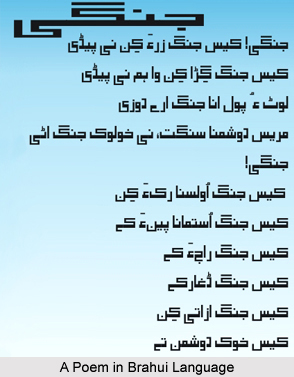 Brahui language is a widely spread language that belongs to the family of Dravidian language. This language is also known as Brahui language. This language is chiefly spoken by the Brahui people of the neighbouring country of Pakistan. In fact, this is the only Dravidian tribal language that is spoken outside India. Brahui language actually belongs to the northern subfamily of Dravidian tribal languages just like Kurukh (Langauge of Oaron Tribe) and Malto languages. This tribal language is heavily influenced by Iranian languages spoken in the area. However, it is believed that Brahui language has been replaced because of excessive influence of the Iranian languages.
Brahui language is a widely spread language that belongs to the family of Dravidian language. This language is also known as Brahui language. This language is chiefly spoken by the Brahui people of the neighbouring country of Pakistan. In fact, this is the only Dravidian tribal language that is spoken outside India. Brahui language actually belongs to the northern subfamily of Dravidian tribal languages just like Kurukh (Langauge of Oaron Tribe) and Malto languages. This tribal language is heavily influenced by Iranian languages spoken in the area. However, it is believed that Brahui language has been replaced because of excessive influence of the Iranian languages.
Grammar of Brahui language
In Brahui language, pronouns of the 1st person have a peculiar and intricate history, which, despite several attempts to clarify their etymology, have remained obscure for many decades. The isolation of Brahui language from the other languages of the family of Dravidian languages, which are mostly spoken in central, eastern and southern regions of India, has actually resulted in tremendous borrowing of words from the non-Dravidian languages such as Sindhi, Persian and Balochi. Moreover, Brahui is not a written language; it is being displaced by its neighbouring languages. Most of the speakers of Brahui language are bilingual.
It is remarkable, like for instance, that the Brahui formants of the singular kind the plural in the 1st person of the verb are distributed in the reverse order as compared with what is found in other languages of the Dravidian language family. Several attempts of explaining the development of Brahui language have ended in failure. One of the descendants of Brahui language is a peculiar indefinite-personal pronoun that possesses only oblique case forms and which is never used without any objective possessive particles. As distinct from a similar process in verb forms of the first person, the original plural pronoun did not take the place of the singular one but, in all appearance, was assimilated by the latter.
This article is a stub. You may enrich it by adding more information to it. You can send your write-up at content@indianetzone.com



















